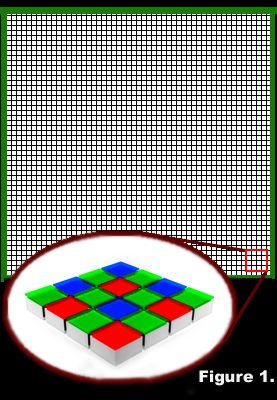
|
|
||||
|
Digital Photography vs
Traditional Photography |
||||||||||||||||||
|
Key points of Traditional Photography: Fixed Film
Speed - once the
camera is loaded with film, you cannot change the
speed of the film. Remember Film Speed is related
to light sensitivity. Fixed Film
Type -once the
Film Type is selected all images will be color
balanced to that type of light. You must use
filters over the lens to shift the color
balance. Aperture -the light
intensity can be controlled by the photographer
using f-stops. This provides creative control too,
by selecting depth of field. Shutter
Speed -the duration
of exposure is selectable by the photographer, and
can also be used for creative control by freezing
motion or allowing it to blur. Lenses -most 35 mm
cameras can be adapted with a variety of lenses
from wide angle to telephoto. Exposure -exposure is
calculated by using a FIXED FILM SPEED and adapting
the SHUTTER SPEED and the APERTURE to
balance. |
||||||||||||||||||

|
Digital Cameras and Photography We'll begin with the fundamental difference between the two technologies. Digital cameras use NO FILM. Digital Cameras use a CCD cell (Charge Coupled Display) to image the photograph. The CCD is an array of individual light sensitive sensors. See Figure 1. The sensors have an array of small built-in filters that provide for the RGB light separation. Each of the individual cells is light sensitive and their combined number represent the resolution of the array. For instance in a digital camera that claims a resolution of 1600 x 1200, there must be at least that many individual cells in the sensor array. More green filters are used than either red or blue as they are in the most sensitive portion of the spectrum, and impart increased sensitivity to the overall array. Below is a photograph of a real ccd cell taken through a microscope at about 10X power. Even at the magnification the individual cells cannot be differentiated. The resolution of the cell is only 512 x 480 and it comes from a real-time video camera used to capture movie video and not still images. |
|||||||||||||||||
|
As mentioned before each cell is light sensitive, so when an image is focused on the array each cell measures the intensity of light striking it. A voltage is generated by the cell which is proportional to the light level. The cell converts light intensity to a voltage. |
||||||||||||||||||
|
The voltage is normalised in an analog to digital converter. (A/D) The A/D converter has a built-in resolution and may be 8 bits, 10 bits, or 12 bits. |
|||||||||||||||||
|
Normalisation means that a uniform scale is applied to the voltage from each cell. If the A/D is an 8 bit A/D then the cell voltages are divided up into 256 parts. One end of the scale either 0 or 255 is applied to the maximum voltage, and the other end is applied to the minimum voltage. These two values define pure black and pure white for the system. Higher bit depth (10 or 12) means more separation in the light intensity hitting each cell and thus smoother variations in light density are achieved. The process is diagrammed below. Figure 2. |
||||||||||||||||||
 Figure2 |
The LENS focuses the image on the ccd array. The cells in the array each produce a voltage based on the light intensity hitting the cell. Each voltage is referenced to a particular cell in the array, and sent to the A/D converter. The A/D converter converts each voltage to a scaled value from 0 to 255. The A/D then passes the scaled integer value to memory in the camera. Each integer value is placed in an associated position in the memory array. Each sensor in the ccd has a specific location that is duplicated in memory. When complete there is a one to one correspondence with the memory integers and their original ccd voltages. |
|||||||||||||||||
|
So now we know how the image is converted from light to interger values in camera memory. Next we need to discuss how resolution and exposure is calculated and handled in the Digital World and see how it compares with that of traditional photography. |
||||||||||||||||||